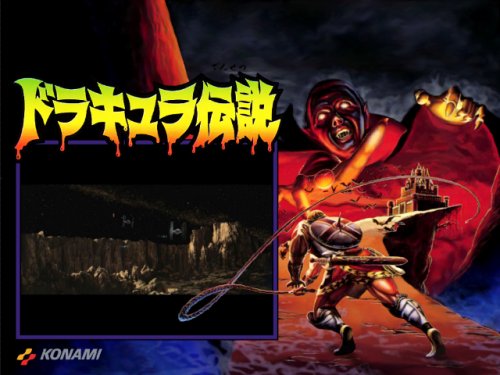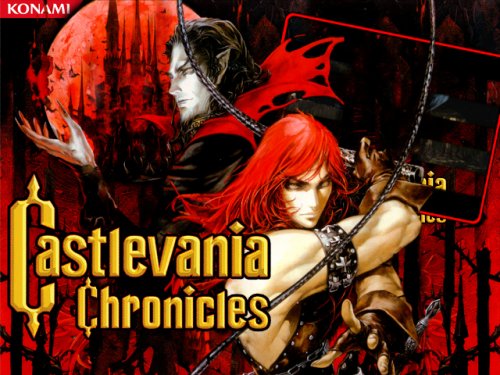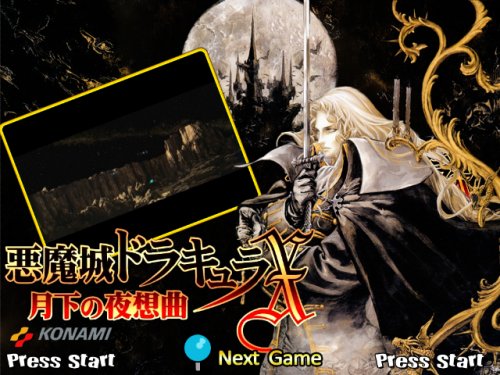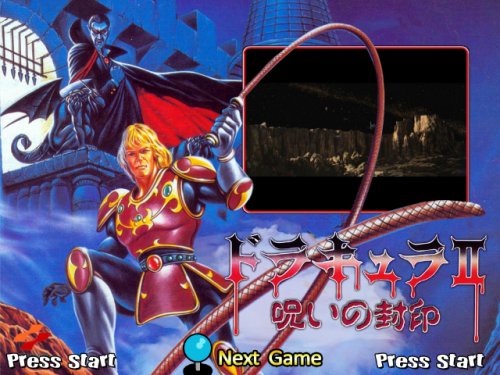Theme by @Bungles
The Walking Dead: Michonne is an episodic interactive drama graphic adventure survival horror based on Robert Kirkman's The Walking Dead comic book series by Telltale Games.[1] Taking place between issues 126 and 139 of The Walking Dead comic series, the game shows events of what Michonne was up to during her temporary departure from the group of survivors led by Rick Grimes in the midst of a zombie apocalypse.[2]Samira Wiley voiced Michonne in the game.[3] The three-episode series was released between February and April 2016 for personal computers, PlayStation 3 and 4 and Xbox 360 and One consoles, and on mobile devices.
<game name="The Walking Dead - Michonne" index="true" image="w">
<description>The Walking Dead - Michonne</description>
<cloneof></cloneof>
<crc></crc>
<manufacturer></manufacturer>
<year></year>
<genre></genre>
<rating>HSRS - M15 (Mature Adults Only)</rating>
<enabled>Yes</enabled>
</game>
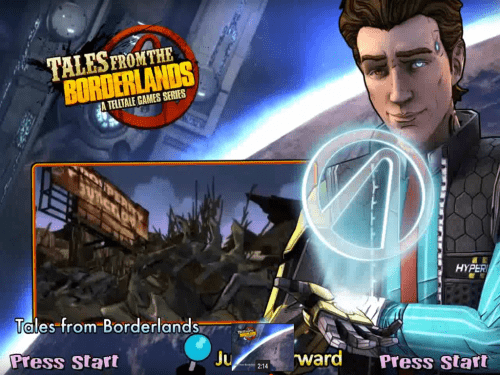
Theme by @Bungles
Tales from the Borderlands is an episodic interactive comedy graphic adventure sci-fi video game based on the Borderlands series, released in November 2014 for Android, iOS, Microsoft Windows, OS X, PlayStation 3, PlayStation 4, Xbox 360, and Xbox One.[1] The game was developed by Telltale Games under license from Gearbox Software, the developer of the Borderlands series, and 2K Games, its publisher. The game follows the episodic format that Telltale used for its titles The Walking Dead and The Wolf Among Us, where player choices and actions have significant effects on later story elements. Although the series received some criticism due to the aging game engine and repetition of gameplay from past Telltale games, Borderlands largely received critical acclaim. Particular praise was attributed to its strong characterization, creative setpieces, humourous writing and unexpected pathos.
<game name="Tales from Borderlands" index="true" image="t">
<description>Tales from Borderlands</description>
<cloneof></cloneof>
<crc></crc>
<manufacturer></manufacturer>
<year></year>
<genre></genre>
<rating>HSRS - M15 (Mature Adults Only)</rating>
<enabled>Yes</enabled>
</game>
Theme by @Bungles
Poker Night 2 is a poker video game developed by Telltale Games.[1] It is the sequel to Poker Night at the Inventory and, like its predecessor, features crossover characters from different franchises. The game was released for Steam, PlayStation Network and Xbox Live Arcade in April 2013, with an iOS version released the following month.[2][3][4]
<game name="Poker Night 2" index="true" image="p">
<description>Poker Night 2</description>
<cloneof></cloneof>
<crc></crc>
<manufacturer></manufacturer>
<year></year>
<genre></genre>
<rating>HSRS - M15 (Mature Adults Only)</rating>
<enabled>Yes</enabled>
</game>
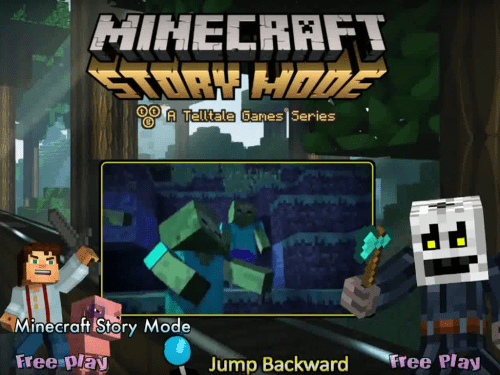
Theme by @Bungles
Minecraft: Story Mode is an episodic point-and-click graphic adventure video game developed and published by Telltale Games, based on the sandbox video game Minecraft. The five-episode game was released between October 2015 through March 2016, and an additional three episodes were released as downloadable content in mid-2016. The game was released for Microsoft Windows, OS X, PlayStation 3, PlayStation 4, PlayStation Vita, Wii U, Nintendo Switch, Xbox 360, Xbox One, Android, iOS, and Apple TV. The game was developed in association with Mojang, the original developer of Minecraft. A retail version was released in December 2016.[13]
The game follows the episodic format that Telltale Games used for its titles The Walking Dead, The Wolf Among Us, Tales from the Borderlands and Game of Thrones. The game centers around a new character, named Jesse, who can be either male or female, as they and their allies attempt to save their world by defeating the Wither Storm
<game name="Minecraft Story Mode" index="true" image="m">
<description>Minecraft Story Mode</description>
<cloneof></cloneof>
<crc></crc>
<manufacturer></manufacturer>
<year></year>
<genre></genre>
<rating>HSRS - PG (Mature Adults Only)</rating>
<enabled>Yes</enabled>
</game>
Theme by @Bungles
Jurassic Park: The Game is an episodic graphic adventure video game based on the Jurassic Park film franchise. The game was developed by Telltale Games as part of a licensing deal with Universal Pictures. The plot of the game takes place during and after the plot of the first film. The game was originally announced in June 2010 before being revealed in the February issue of Game Informer. The first episode was expected for release in April 2011,[1] but was pushed back to November 15[2] along with the PlayStation 3 and Xbox 360 release, resulting in a multi-platform release with all four episodes at once.[3]
<game name="Jurassic Park" index="true" image="j">
<description>Jurassic Park</description>
<cloneof></cloneof>
<crc></crc>
<manufacturer></manufacturer>
<year></year>
<genre></genre>
<rating>HSRS - M15 (Mature Adults Only)</rating>
<enabled>Yes</enabled>
</game>
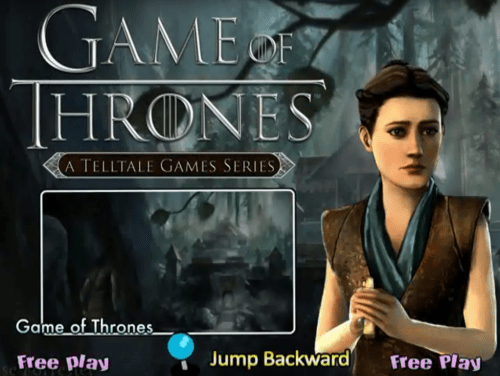
Theme by @Bungles
Game of Thrones is an episodic graphic adventure fantasy drama video game based on the George R. R. Martin A Song of Ice and Fire fantasy novel TV adaptation Game of Thrones, released in December 2014 for Android, iOS, Microsoft Windows, OS X, PlayStation 3, PlayStation 4, Xbox 360, and Xbox One.
The game was developed by Telltale Games and follows the episodic format found in other Telltale titles, such as The Walking Dead, The Wolf Among Us, and Tales from the Borderlands, where player choices and actions influence later events across the 6-episode arc. The story revolves around the northern House Forrester, rulers of Ironrath, whose members, including the five playable characters, attempt to save their family and themselves after ending up on the losing side of the War of the Five Kings. The game includes settings, characters and voice actors from the novels and TV series.
The game was generally well received, and Telltale is currently working on a second season of the game.
<game name="Game of Thrones" index="true" image="g">
<description>Game of Thrones</description>
<cloneof></cloneof>
<crc></crc>
<manufacturer></manufacturer>
<year></year>
<genre></genre>
<rating>HSRS - M15 (Mature Adults Only)</rating>
<enabled>Yes</enabled>
</game>
Theme by @Bungles
Batman: The Telltale Series is a 2016 episodic point-and-click graphic adventure video game developed and published by Telltale Games and distributed by Warner Bros. Interactive Entertainment under its DC Entertainment label. The game is based on Bob Kane and Bill Finger's Batman character, though not tied to any previous adaptation of the work in film or other media.
<game name="Batman - Telltale Series" index="true" image="b">
<description>Batman - Telltale Series</description>
<cloneof></cloneof>
<crc></crc>
<manufacturer></manufacturer>
<year></year>
<genre></genre>
<rating>HSRS - M15 (Mature Adults Only)</rating>
<enabled>Yes</enabled>
</game>
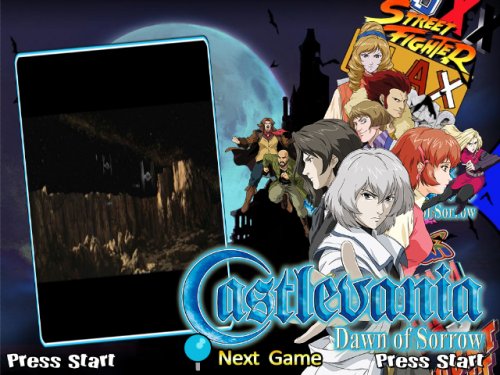
Nintendo DS - Castlevania - Dawn of Sorrow (USA)-klopjero(20170406)
Castlevania: Dawn of Sorrow, known in Japan as Akumajō Dracula: Sōgetsu no Jūjika (悪魔城ドラキュラ 蒼月の十字架?, literally Devil's Castle Dracula: Cross of the Blue Moon),[2] is an action-adventure game developed and published by Konami. It is part of Konami's Castlevania video game series and the first Castlevania game to be released on the Nintendo DS. The game is the sequel to Castlevania: Aria of Sorrow and incorporates many elements from its predecessor. Dawn of Sorrow was commercially successful, selling more than 15,000 units in its first week in Japan and 164,000 units in the United States three months after its initial release.[3][4]
Dawn of Sorrow continues the story of Aria of Sorrow, in which Dracula has been completely defeated, and his powers assumed by his reincarnation, Soma Cruz. With the help of his allies, Soma avoids becoming the new dark lord. A cult forms to bring forth a new dark lord by killing Soma. Soma and his allies move to ensure that a new dark lord is not created.
Dawn of Sorrow incorporates many features from previous Castlevania games: the combination of elements from platform games and role-playing video games, the "Tactical Soul" system featured in Aria of Sorrow, and a dark, gothic atmosphere.[5][6] Dawn of Sorrow also introduces new gameplay elements, such as the "Magic Seal" system, which requires the use of the DS stylus to draw a pattern in order to defeat powerful enemies,[5] a distinctive anime character design,[7] and a multiplayer mode, where two players compete for fastest times on a prerendered level.[6] The game received high scores from many video game publications, and was considered one of the best games on the Nintendo DS for 2005. The game was re-released in Japan on June 29, 2006 and later in North America during 2007 as part of the "Konami the Best" line.[1]
Castlevania: Order of Ecclesia, known in Japan as Akumajō Dracula: Ubawareta Kokuin (悪魔城ドラキュラ 奪われた刻印?, lit. Devil's Castle Dracula: The Stolen Seal),[5] is a platform-adventure game and the third Nintendo DS installment of the Castlevania franchise. Directed by Akihiro Minakata, with long time producer Koji Igarashi returning. The plot involves Shanoa, who is part of an organization set to defeat Dracula after the Belmont clan has vanished.
Database entry:
<game name="Akumajou Dracula Ubawareta Kokuin (Japan)" index="true" image="A">
<description>Akumajou Dracula Ubawareta Kokuin</description>
<cloneof></cloneof>
<crc></crc>
<manufacturer></manufacturer>
<year></year>
<genre></genre>
<rating>Other - NR (Not Rated)</rating>
<enabled>Yes</enabled>
</game>
Castlevania: Order of Ecclesia, known in Japan as Akumajō Dracula: Ubawareta Kokuin (悪魔城ドラキュラ 奪われた刻印?, lit. Devil's Castle Dracula: The Stolen Seal),[5] is a platform-adventure game and the third Nintendo DS installment of the Castlevania franchise. Directed by Akihiro Minakata, with long time producer Koji Igarashi returning. The plot involves Shanoa, who is part of an organization set to defeat Dracula after the Belmont clan has vanished.
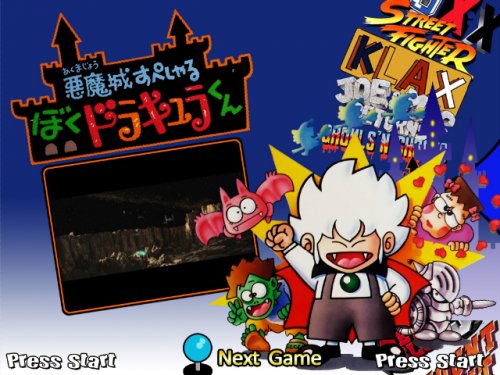
Akumajou Special - Boku Dracula-kun (Japan) (Translated En)
Akumajō Special: Boku Dracula-kun (悪魔城すぺしゃる ぼくドラキュラくん Akumajō Supesharu: Boku Dorakyura-kun?, lit. "Demon Castle Special: I'm Kid Dracula") is a platformer video game made by Konami. It was released only in Japan for the Famicom on 19 October 1990.[1] The game was never localized outside Japan until a fan created translation was released in 2003. It is considered a parody of the Castlevania series. A version for mobile phones was also released on 30 June 2006 in Japan only.
Easter Egg
At the title screen, entering the Konami Code (Up, Up, Down, Down, Left, Right, Left, Right, B, A) will give a tone for correct code entry. Pressing Start, however, gives you nothing more than a mocking message.
Japanese
English
ざんねんでした。 なにもないよ~ん!
Too bad. There's nothing here!
The program code were intended to have more than one cheat codes at once, but there is only one cheat entry left in the pointer table for the cheats, the rest is removed at some point. However, some coding for at least one more additional cheat flag exist in the game. Code PAVLSYAA will replace the easter cheat effect with the scrapped unused one, which will gives to you extra 50 lives instead at the start of the new game.
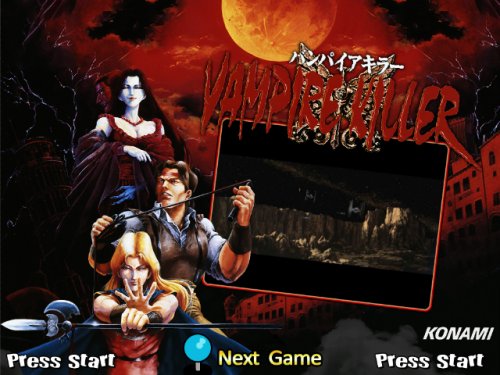
Sega Mega Drive - Akumajou Dracula - Vampire Killer (Japan)-klopjero
Castlevania: Bloodlines, known as Vampire Killer[a] in Japan and as Castlevania: The New Generation in PAL regions, is a platform game developed and published by Konami for the Sega Genesis, released worldwide in March 1994. It was the only Castlevania video game released on the Genesis.
The game's storyline concerns a legendary vampire named Elizabeth Bartley who is Dracula's niece, suddenly appearing in the 20th century. Plotting a sacrificial war in order to bring her uncle back to life, she orchestrates the beginning of World War I. Quincy Morris' son, John, and his best friend Eric Lecarde, vow to take up the fight against evil. Together they manage to prevent Dracula's full resurrection.
Unlike most Castlevania games, Bloodlines was the first game in the series that does not take place exclusively in Dracula's castle, with most levels taking place throughout Europe.
Regional Differences
Title Screen
Japan
US
Europe
The Japanese title, strangely, is not some variant on Akumajou Dracula but instead simply Vampire Killer. The censorship of blood in the European version extended to the title, and not only graphically, as the game is called Castlevania: The New Generation.
Characters
Japan
US/Europe
Eric Lecarde's face was significantly less masculine looking in the Japanese version's introduction and Expert ending.
US/Europe
Japan
John Morris is called Johnny Morris in the Japanese version.
Passwords
The Japanese version handles passwords differently - instead of showing passwords in between levels, in the Japanese version passwords are shown after the End option is chosen on the game over screen.
Blood
Blood has been removed from the European version in various ways:
US/Japan
Europe
The dead zombie outside of Castle Dracula, which some crows are feeding on, was removed in the European version.
US/Japan
Europe
The zombies were changed from pink with red blood to a greenish blue with green blood in the European version.
US/Japan
Europe
Hung corpses and blood dripping from the platforms of Stage 1 and Stage 6-2 were removed entirely in the European version as well.
US/Japan
Europe
Due to the aforementioned objection to blood itself (again!), the blood fountain in Stage 5-1 was changed to a boring regular fountain when walking past it. The Blood Skeleton surprisingly survived the censorship.
US/Japan
Europe
Eric no longer get impaled when he dies in the European version.

Castlevania, known in Japan as Akumajou Dracula (悪魔城ドラキュラ Akumajō Dorakyura?, officially translated Devil's Castle Dracula),[6] is an action-platformer video game developed and published by Konami for the Family Computer Disk System video game console in Japan in September 1986. It was ported to cartridge format and released in North America for the Nintendo Entertainment System (NES) in May 1987 followed by a European release in 1988.
The game takes place in the year 1691 where players control Simon Belmont who is tasked with defeating the vampire Dracula. It was re-released for the Family Computer (FC) in cartridge format in 1993. It is the first game in Konami's Castlevania video game series; it was followed by two more NES games titled Castlevania II: Simon's Quest (released for the NES in 1988) and Castlevania III: Dracula's Curse (1989). A fourth game, retelling the events of the original, was released for the Super NES and titled Super Castlevania IV.
Castlevania was positively received and financially successful. It is considered an NES classic by PC World, while Nintendo Power and Game Informer ranked it in their best video games list (at 22 and 48 respectively). IGN ranked it 19 among their favourite NES games.
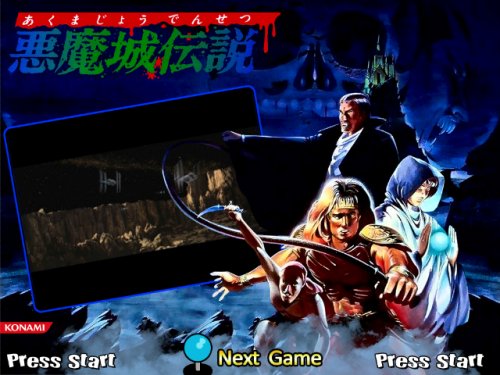
Nintendo Famicom - Akumajou Densetsu (Japan)-klopjero
Castlevania III: Dracula's Curse, known in Japan as Akumajō Densetsu (悪魔城伝説?, literally Devil's Castle Legend),[2] is the third and final Castlevania video game produced for the Nintendo Entertainment System. It was published by Konami in Japan in 1989, in North America in 1990, and in Europe in 1992 (some time after the European release of Super Castlevania IV). It was later released on the Wii Virtual Console in the PAL regions on October 31, 2008, in North America on January 12, 2009 and in Japan on April 21, 2009.
The plot of Castlevania III: Dracula's Curse is a prequel to the original Castlevania (much like the earlier Game Boy game Castlevania: The Adventure) set a few centuries before the events of the original game. The game's protagonist is Trevor C. Belmont, an ancestor of the original hero Simon Belmont.
Regional Differences
Castlevania III managed to slip a lot of religious imagery under Nintendo's radar, but all of the game's nudity has been censored. Some graphics and palettes have also been improved.
Akumajou Densetsu
Castlevania III
The nude statues seen on the name entry screen and password screen have been given dresses and their shading has been updated. The vines that were originally on the statues were removed. Castlevania III also uses a much more stylish font than Akumajou Densetsu. Amusingly, the opposite went on to happen in Castlevania IV.
Akumajou Densetsu
Castlevania III
The same also applies to the nude statues at Block 8-01 in Dracula's Curse.
Akumajou Densetsu
Castlevania III
The cross in the intro scene originally had a "glowing" effect surrounding it, which was removed in Castlevania III.
Akumajou Densetsu
Castlevania III
Medusa lost her female characteristics in Dracula's Curse.
Akumajou Densetsu
Castlevania III
Besides the breast reduction, the completely messed up animation frame for her aiming upward stance was cleaned up. Still, three of her animation frames were less than perfect. Her head looks suspiciously mispositioned in one of her aiming straight ahead frames.
A few Medusa-tiles went unused in the Japanese ROM, an arm meant for the glitchy animation frame. And a different part of the body found in both ROMs, meant for this frame:
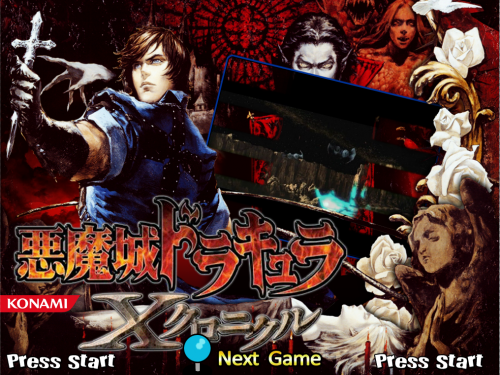
Castlevania: The Dracula X Chronicles, known in Japan as Akumajō Dracula X Chronicle (悪魔城ドラキュラ Xクロニクル Akumajō Dorakyura Ekkusu Kuronikuru?, lit. "Devil's Castle Dracula X Chronicle")[29] is a 2.5D remake of Rondo of Blood for the PlayStation Portable.[8] It includes the original game and a port of its sequel, Symphony of the Night, as unlockable content.[1] Symphony of the Night includes the option to play as Maria (as did the Sega Saturn version, but based on the Rondo of Blood version), as well as redone scripts, sound effects and new voice acting.[30] Gameplay in The Dracula X Chronicles remains largely unchanged from Rondo of Blood.[31] However, a Boss Rush mode was added; completion of it three times unlocks the mini-game Peke.[32] It was released in North America on October 23, 2007, in Japan on November 8, 2007, in Europe on February 15, 2008 and in Australia & New Zealand on April 9, 2008.[33] In 2008, the North American edition was re-released as part of the "Greatest Hits" label while the Japanese edition was re-released on July 15, 2010 under the "Best Selection" label.[33] The game was added to the PlayStation Network in Europe in June 2014, as a PSP-only release (the game is already compatible with the PS Vita).[34]
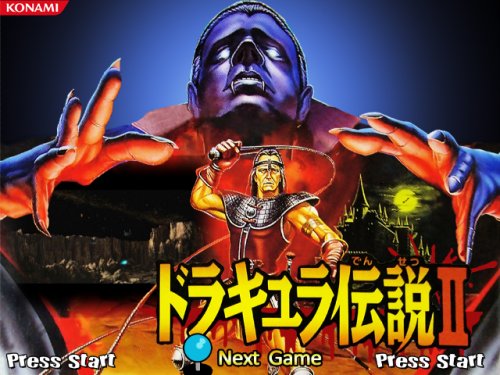
Nintendo Gameboy - Dracula Densetsu II (Japan)-klopjero(20170316)
Castlevania II: Belmont's Revenge, known as Dracula Densetsu II (ドラキュラ伝説II?, officially translated The Legend of Dracula II)[1] in Japan, is a platform game released for the Game Boy in 1991. It is the second Castlevania title for the Game Boy and serves as a sequel to the previous title, Castlevania: The Adventure. Belmont's Revenge is included in color in the fourth volume of the Konami GB Collection compilations.[2] Set fifteen years after the events of Castlevania: The Adventure, Dracula returns and kidnaps Christopher Belmont's son Soleiyu at his coming of age feast, and turns him into a demon. With Soleiyu's mystical powers, Dracula retakes human form and rebuilds his castle, forcing Christopher to confront Dracula once again to save his son and Transylvania.[3][4]
Regional Changes
Sound Test Titles
As seen above, the track titles were changed to generic names in the overseas releases, likely done to remove their religious references.
Japan
US
Info
NEW MESSIAH
BGM 1
Crystal Castle
PRAYING HANDS
BGM 2
Cloud Castle
RIPE SEEDS
BGM 3
Plant Castle
PSYCO WARRIOR
BGM 4
Rock Castle
ORIGINAL SIN
BGM 5
Dracula Castle 1
PASSPIED
BGM 6
Dracula Castle 2-1
EVIL GODS
BOSS 1
Regular boss
C.PHANTASIE
BOSS 2
Dracula Castle 2 boss
SONS OF SATAN
BOSS 3
Final boss
SOLEIYU
DEMO 1
Dracula Castle map
FAITH
DEMO 2
Dialogue
NEW CHURCH
SELECT BGM
Stage select
Weapons
Japan
US
While both regions of the game share the Holy Water, the other weapon is different in each. The Japanese version offers a boomerang, but the US version has the axe, either because it was more useful or less broken.
.thumb.png.3fdfad30521f8ecbf525be1c528d1fca.png)
Akumajou Dracula (Japan)
Super Castlevania IV (Japanese: 悪魔城ドラキュラ Hepburn: Akumajō Dorakyura?, Devil's Castle Dracula[2]) is a platform game developed and published by Konami and the first Castlevania game for the Super Nintendo Entertainment System. The game was originally released in 1991 and later re-released on the Virtual Console in 2006 for the Wii,[3] in 2013 for the Wii U, and in 2016 for the New Nintendo 3DS.[4] It features expanded play control, 16-bit graphics featuring SNES Mode 7, and a soundtrack featuring brand new pieces and arrangements based on previous Castlevania music. Following the same setting as Castlevania on the NES, the game takes place in 1691 Transylvania, where the vampire hunter Simon Belmont must defeat the vampire Dracula.[3][5]
======================
source:http://www.movie-censorship.com/report.php?ID=3424
One of the oldest and often continued game series released by Konami is the "AkumaJou Dracula"-saga, in Western countries better known as "Vampire Killer" and most frequently known as "Castlevania".
The first of the two games For Nintendo's Super Famicom/SNES was released in Japan as well as internationally, however, some of the details were censored for the translated versions.
This is a comparison between the uncensored Japanese Super Famicon version and the censored North American SNES version. The censorship can be found in any international version - the Japanese version is the only uncensored version in existance.
On the left side you will always find the images from the uncensored version. The following things were altered:
The dripping blood during the title screen was deleted.
During the intro, the cross on Dracula's tombstone was deleted and you can no longer read the name.
The tombstones in stage 2 also miss out on the crosses.
The statues are a little more revealing in the uncensored version.
The blood during the levels was re-colored: in the original version it's red, while in the censored version it's green. The same thing happened with all the drips that fall from the ceiling and hurt you.
The coffin-enemies also miss out on the corsses.
I re-used your theme again @JSinn, because, you know..it's so frekin awesome.
check his it out:
Castlevania: The Adventure, known as Dracula Densetsu (ドラキュラ伝説 Dorakyura Densetsu?, lit. The Legend of Dracula[2]) in Japan, is a platform game released for the Game Boy in 1989. It is the first Castlevania title for the system. Castlevania: The Adventure was re-released in color as part of the Konami GB Collection compilations in Japan and Europe. A remake titled Castlevania: The Adventure ReBirth was released as a WiiWare game for the Wii.
For US/EU Version (Castlevania - adventure) click here
Castlevania Chronicles, released in Japan as Castlevania Chronicle: Akumajō Dracula (悪魔城年代記キャッスルヴァニアクロニクル 悪魔城ドラキュラ Kyassuruvania Kuronikuru Akumajō Dorakyura?), is a platform video game developed by Konami for the PlayStation.[1] It is a port of a game originally released for the Sharp X68000 home computer in 1993 as simply Akumajō Dracula (悪魔城ドラキュラ Akumajō Dorakyura?, "Devil's Castle Dracula").[2] This Castlevania Chronicles port adds a number of features, including an Arranged Mode for new players.[3][4] Much like Super Castlevania IV, Castlevania Chronicles is positioned as a remake of the original Castlevania for the Nintendo Entertainment System, where the vampire hunter Simon Belmont must defeat Dracula and save Transylvania.
Castlevania: Symphony of the Night (Japanese: 悪魔城ドラキュラX 月下の夜想曲 Hepburn: Akumajō Dracula X: Gekka no Yasōkyoku?, Devil's Castle Dracula X: Nocturne in the Moonlight)[1][2] is a platform-adventureaction role-playing game (or Metroidvania) developed and published by Konami in 1997 for the PlayStation. It is the sequel to Castlevania: Rondo of Blood and features Dracula's dhampir son Alucard as the protagonist.[3]It marks a break from previous games in the series, which are action platformers. The game emphasizes exploration, has non-linear level design, and Role-playing video game elements.
Initially, the game was unsuccessful[4] – particularly in the United States where it was meagerly publicized – but thanks to praise by critics, it gained sales through word-of-mouth and became a hit. It has been re-released on several consoles and is considered a sleeper hit, a cult classic, and one of the best video games ever made.
Akumajou Dracula II - Noroi no Fuuin (Japan)
21-3-2017
Provided wheel image
Castlevania II: Simon's Quest, known in Japan as Dracula II: Noroi no Fūin (ドラキュラII 呪いの封印 Dorakyura Tsū: Noroi no Fūin?, "Dracula II: The Seal of the Curse"), is a platform-adventure video game produced by Konami.[7] It was originally released for the Family Computer Disk System in Japan 1987 and for the Nintendo Entertainment System in North America in 1988. It is the second Castlevania title released for the NES, following the original Castlevania. Set sometime after the events of the first installment,[8] the player once again assumes the role of vampire hunter Simon Belmont, who is on a journey to undo a curse placed on him by Dracula at the end of their previous encounter. With Dracula's body split into five parts after his defeat, Simon must find and bring them to the ruins of his castle to seal and defeat him.[9]
For US/EU version (Castlevania - Simon's Quest) click here
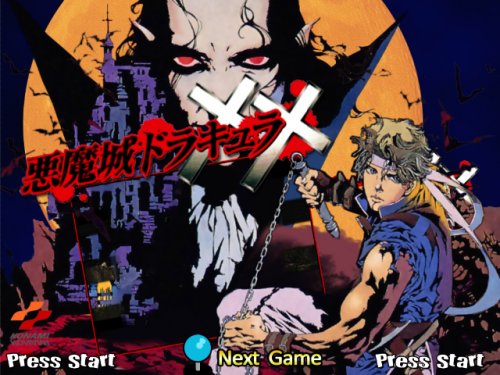
Super Famicom - Akumajou Dracula XX (Japan)-klopjero(20170221)
database:
<game name="Akumajou Dracula XX (Japan)" index="" image="">
<description>Akumajou Dracula XX</description>
<cloneof></cloneof>
<crc></crc>
<manufacturer>Konami</manufacturer>
<year>1995</year>
<genre>Platform</genre>
<rating>Other - NR (Not Rated)</rating>
<enabled>Yes</enabled>
</game>
Castlevania: Dracula X, known as Akumajou Dracula XX (悪魔城ドラキュラXX Akumajō Dorakyura XX?) in Japan and Castlevania: Vampire's Kiss in Europe,[27] was developed for the Super Nintendo Entertainment System.[3] While the plot is similar to Rondo of Blood and it uses many of the latter's graphics, it featured a different art style, redesigned levels, and altered gameplay elements (such as having only two alternate levels and Maria as a nonplayable character).[3][22][28] It was released on July 21, 1995 in Japan, in September 1995 in the USA and Europe,[27] and on June 22, 1996 in Australia as an uncensored release.[citation needed] The game was also released as a Wii U Virtual Console download in Japan on April 23, 2014, in North America on October 2, 2014 and the PAL regions on November 13, 2014. A version for the New Nintendo 3DS was released in North America on December 29, 2016, and in Europe and Australia on January 26, 2017.
For PAL Version (castlevania - Vampire's Kiss)click here
For US Version (Castlevania - Dracula X) click here
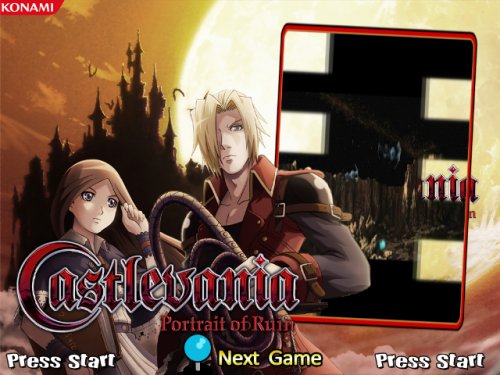
Castlevania: Portrait of Ruin, known in Japan as Akumajō Dracula: Gallery of Labyrinth (悪魔城ドラキュラ ギャラリー・オブ・ラビリンス?, translated Devil's Castle Dracula: Gallery of Labyrinth),[4] is a platform-adventure game developed and published by Konami.[3] The game was released on November 16, 2006 in Japan, and in the US on December 5, 2006 for the Nintendo DS handheld game console.[5] Portrait of Ruin is the first Castlevania to feature a cooperative multiplayer gameplay mode and the first handheld Castlevania to have English voice-overs, outside of its original Japanese release.
Portrait of Ruin is set in 1944 Europe during World War II,[6] and is a continuation of the story from Castlevania: Bloodlines.[7] The game introduces new protagonists and antagonists to the Castlevania series as well as expand on the two character gameplay found in the previous Nintendo DS Castlevania title, Castlevania: Dawn of Sorrow. Portrait of Ruin has met with an overall positive critical response and has received high ratings from reviews, along with several awards.
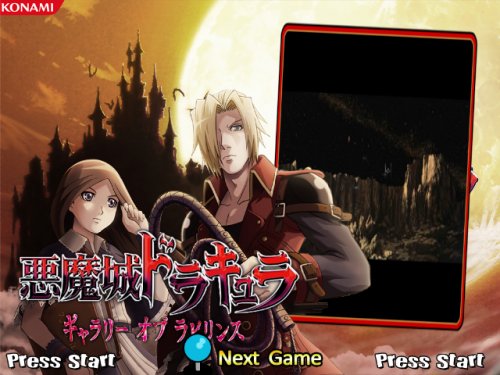
Nintendo DS - Akumajou Dracula - Gallery of Labyrinth (Japan)
Database:
<game name="Akumajou Dracula - Gallery of Labyrinth (Japan)" index="" image="">
<description>Akumajou Dracula - Gallery of Labyrinth</description>
<cloneof></cloneof>
<crc></crc>
<manufacturer>Konami</manufacturer>
<year>2006</year>
<genre></genre>
<rating>Other - NR (Not Rated)</rating>
<enabled>Yes</enabled>
-----------
Castlevania: Portrait of Ruin, known in Japan as Akumajō Dracula: Gallery of Labyrinth (悪魔城ドラキュラ ギャラリー・オブ・ラビリンス?, translated Devil's Castle Dracula: Gallery of Labyrinth),[4] is a platform-adventure game developed and published by Konami.[3] The game was released on November 16, 2006 in Japan, and in the US on December 5, 2006 for the Nintendo DS handheld game console.[5] Portrait of Ruin is the first Castlevania to feature a cooperative multiplayer gameplay mode and the first handheld Castlevania to have English voice-overs, outside of its original Japanese release.
Portrait of Ruin is set in 1944 Europe during World War II,[6] and is a continuation of the story from Castlevania: Bloodlines.[7] The game introduces new protagonists and antagonists to the Castlevania series as well as expand on the two character gameplay found in the previous Nintendo DS Castlevania title, Castlevania: Dawn of Sorrow. Portrait of Ruin has met with an overall positive critical response and has received high ratings from reviews, along with several awards.
Regional Differences
Typos
US
Europe
Richter's name was spelled as "RICHITER" on the Japanese and US versions' file select screen (Due to an apparently miss in Japanese-English spelling conversion). This was corrected in the European version, and Japanese revision (NDS-6081).
US
Europe
Charlotte's name was missing an L on the Equip screen (also because Japanese-English spelling transition cases). This was also fixed in the European version and later Japanese revision.
Glitch Fixes
There are several glitches and exploits in Portrait of Ruin in other countries that that got fixed for the European release, and Japanese revision (NDS-6081).
Item duplication exploit for Eric's Quest rewards no longer work. Players are no longer able to skip Eric's congratulatory line about finishing the quest with the Start button.
Somewhat a hidden (and possibly accidental) staple since Symphony of the Night, players are no longer able to glitch out of the roofs in the Great Stairways.
A glitch involving being locked in Death's room after beating and skipping the boss' dialogue was also fixed.
Finally, there is an exploitable glitch about carrying over progress (all, including stats, map and even the same save point) to a new level-cap game which unsurprisingly gets fixed as well.
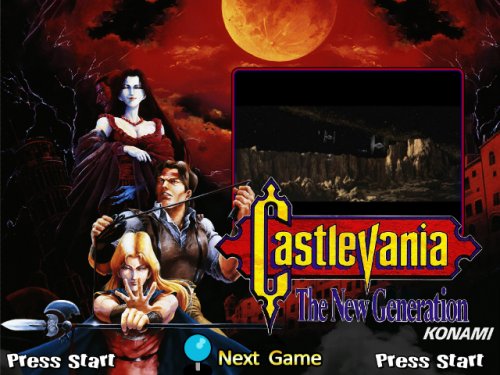
Sega Mega Drive - Castlevania - The New Generation (Europe)-klopjero
Castlevania: Bloodlines, known as Vampire Killer[a] in Japan and as Castlevania: The New Generation in PAL regions, is a platform game developed and published by Konami for the Sega Genesis, released worldwide in March 1994. It was the only Castlevania video game released on the Genesis.
The game's storyline concerns a legendary vampire named Elizabeth Bartley who is Dracula's niece, suddenly appearing in the 20th century. Plotting a sacrificial war in order to bring her uncle back to life, she orchestrates the beginning of World War I. Quincy Morris' son, John, and his best friend Eric Lecarde, vow to take up the fight against evil. Together they manage to prevent Dracula's full resurrection.
Unlike most Castlevania games, Bloodlines was the first game in the series that does not take place exclusively in Dracula's castle, with most levels taking place throughout Europe.
Regional Differences
Title Screen
Japan
US
Europe
The Japanese title, strangely, is not some variant on Akumajou Dracula but instead simply Vampire Killer. The censorship of blood in the European version extended to the title, and not only graphically, as the game is called Castlevania: The New Generation.
Characters
Japan
US/Europe
Eric Lecarde's face was significantly less masculine looking in the Japanese version's introduction and Expert ending.
US/Europe
Japan
John Morris is called Johnny Morris in the Japanese version.
Passwords
The Japanese version handles passwords differently - instead of showing passwords in between levels, in the Japanese version passwords are shown after the End option is chosen on the game over screen.
Blood
Blood has been removed from the European version in various ways:
US/Japan
Europe
The dead zombie outside of Castle Dracula, which some crows are feeding on, was removed in the European version.
US/Japan
Europe
The zombies were changed from pink with red blood to a greenish blue with green blood in the European version.
US/Japan
Europe
Hung corpses and blood dripping from the platforms of Stage 1 and Stage 6-2 were removed entirely in the European version as well.
US/Japan
Europe
Due to the aforementioned objection to blood itself (again!), the blood fountain in Stage 5-1 was changed to a boring regular fountain when walking past it. The Blood Skeleton surprisingly survived the censorship.
US/Japan
Europe
Eric no longer get impaled when he dies in the European version.

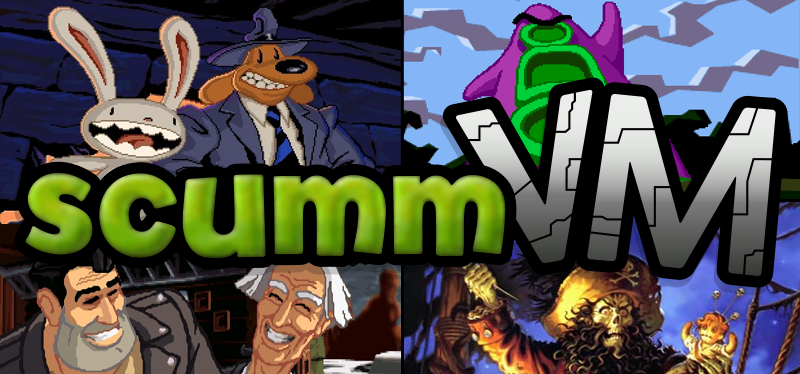
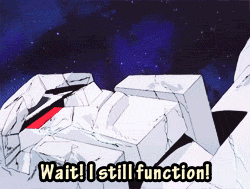
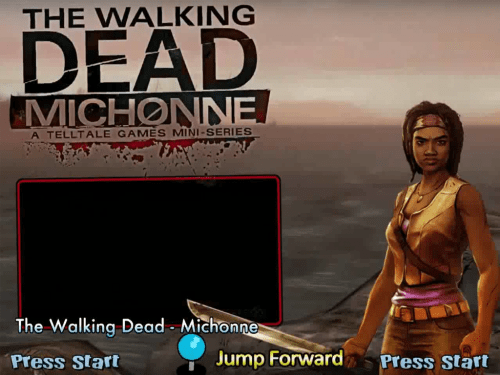

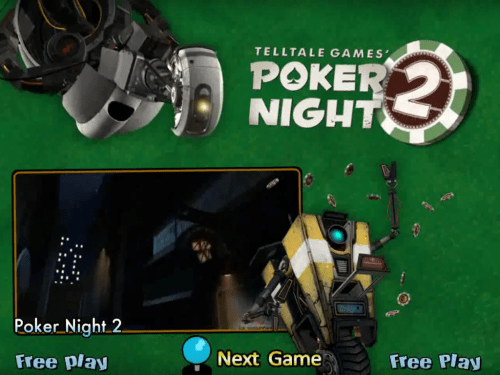

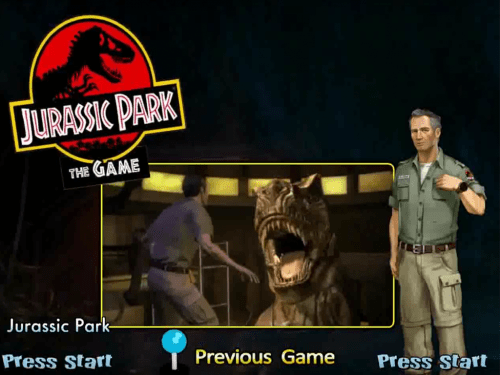

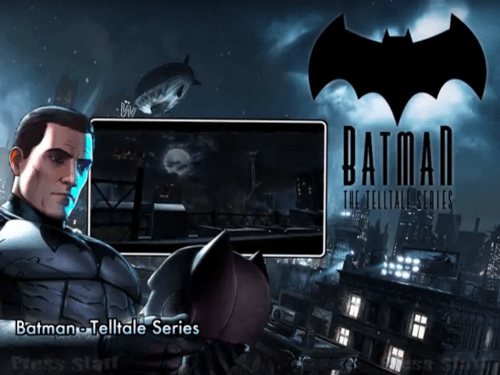


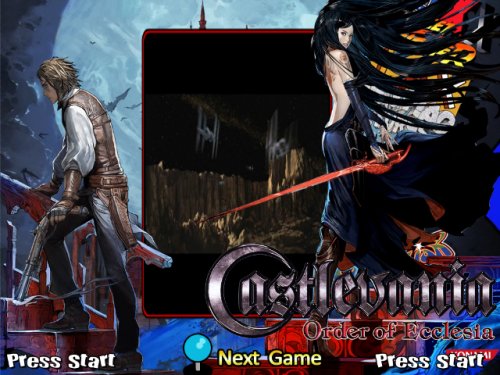






.thumb.png.3fdfad30521f8ecbf525be1c528d1fca.png)
